Western decay gives subject to Chinese caricatures
Latvia is not Lithuania, which is conducting an experiment on the anger of the People's Republic of China (PRC) for a fee unknown to the public. However, Latvia has also complied with the joint and categorical demand of the US and the European Union to expel Chinese businessmen and buyers of residence permits. Has Latvia thus aligned itself with the truly strong or with the nervous?
Last year, the bloc of countries living under the protection of the US on the one hand, and the PRC on the other, continued to exchange accusations. On June 13, the meeting of the G7 in England rebuked China for human rights violations in Xinjiang and Hong Kong, to which China responded the following day with an equally strong rebuke: "The Group of Seven (G-7) takes advantage of Xinjiang-related issues to engage in political manipulation and interfere in China’s internal affairs, which we firmly oppose"; the PRC accused the G7 of "lies, rumours and baseless accusations".
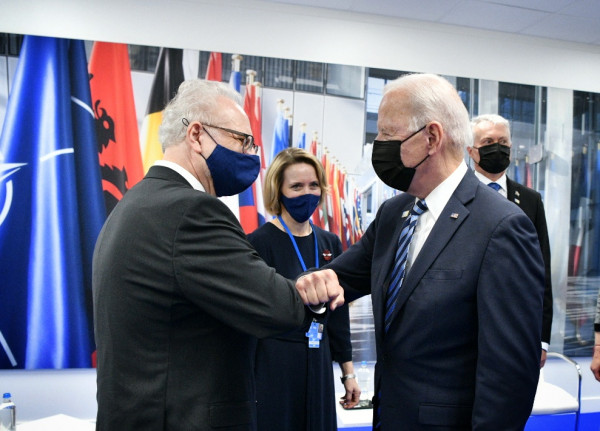
The G7 leaders meanwhile moved to Brussels and joined senior officials from NATO member states, including the President of Latvia, Egils Levits. His office keeps photographic evidence of his meeting with US President Joe Biden on June 14 (pictured). In the course of the joint and bilateral meetings, a statement was agreed that China's ambitions and behavior posed "systemic challenges to the rules-based international order". In E. Levits' words, "the NATO summit in Brussels was historic". In particular, "the US reiterated very clearly and unequivocally that it stands with its NATO allies and that NATO is united. United to defend its interests and its values. (...) In the new geopolitical situation where democracies have to compete with authoritarian powers like Russia and China, all the democracies that are in this alliance have to stand together." The PRC did not miss a chance to reply and advised NATO to "view China’s development rationally, stop exaggerating various forms of ‘China threat theory’ and not to use China’s legitimate interests and legal rights as excuses for manipulating group politics".
To prevent the public exchange of deep concern about genuine worries and vice versa from leading to an entirely comic effect, the parties also took care to use words that already border on deeds. On the US side, Lithuania was hired as such a doer. In May, it announced its withdrawal from the 17+1 cooperation format, well known to Latvia since November 2016, when the then still 16+1 heads of state gathered in Riga.
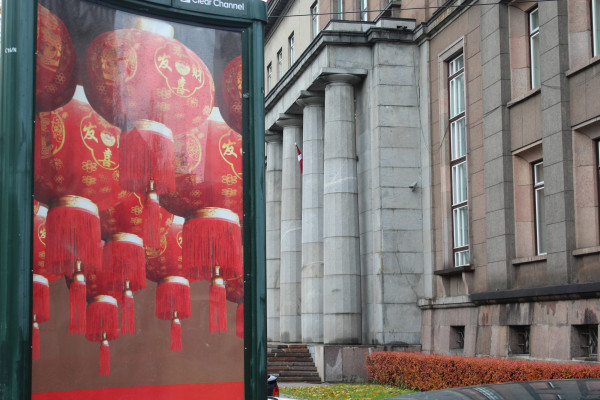
There was also a time when Latvian officials tried very, very hard to give the impression that the location of the meeting would give Latvia an advantage in the fight with its then 15 rivals for the biggest Chinese favor, which would translate into cash flows to Latvia. First, Prime Minister Laimdota Straujuma boasted of persuading the Chinese to come to Latvia, then Māris Kučinskis said he had taken her ideas and used them to the best advantage. A few million euros were written off for the event, including Riga decorated with Chinese colors and ornaments (pictured), but in reality, Latvia gained nothing - no container transport by rail, no direct Riga-China flight, there were only 3-4 candidate cities named for maintaining air traffic with the transit hub on the eastern periphery of the European Union. Real life has confirmed by a hair's breadth the arguments against maintaining Latvia-China relations above the norms of emphatically cool politeness, as written by Neatkarīgā on September 27, 2016, with reference to Professor Igors Kabaškins of the Institute of Transport and Communications:
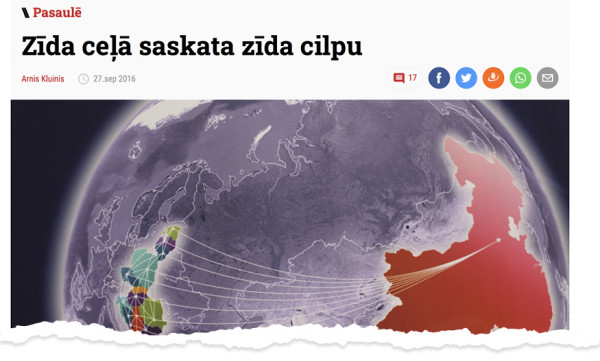
- Latvian officials understand everything, but equally understandable are the reasons why they pretend not to understand that talking about the flow of Chinese goods is just a pretext for the flow of the Chinese themselves to Latvia. The state officials do not consider it possible to admit publicly what I. Kabaškins said, that "China has a lot of money for which it is ready to build its own factories on Latvian territory, to import its own specialists and to produce Chinese products on European territory. There is already such cooperation between China and Eastern Europe. For example, in Minsk, Belarus, the Chinese are building a whole Chinese city where various companies are producing all sorts of goods close to the trading places." His remarks, translated into Latvian by the Russian news agency Sputnik, are even more poignant: "Is such a city possible in Latvia? On the one hand, we have a lot of abandoned plots of land and the country needs modern manufacturing like fish need water, but on the other hand, xenophobia is very common in our country and is often supported by the state. Latvians are just as much Sinophobic as Arabophobic, and certainly more so than Russophobic. That is why there is still the question of whether the Chinese will even be willing to come here to our 'welcoming' country.
It is a small consolation that the Chinese town built near Minsk also turned out to be a political town, a signboard without any real economic opportunities. Nothing of note can be produced there or in Belarus, which is cut off from the Western world.
Lithuania's withdrawal from a virtually dead organization was reminiscent of the rituals of old, and not so old, times to hang, whip or at least display for public viewing the dead bodies of those who have particularly sinned before laying them in the grave. However, this, as well as the gift of Covid vaccines to Taiwan, was only a warm-up for the Lithuanian crown jewel - the permission for Taiwan to open a Taiwanese Representative Office in Lithuania on November 18, 2021.
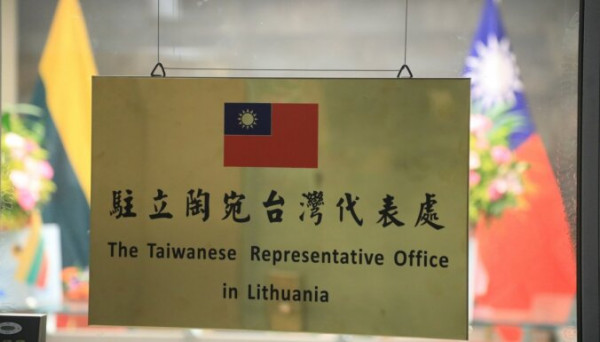
This sign (pictured) replaced the de facto Taiwanese embassy masquerading as the Taipei Economic and Cultural Office. Again, it's just replacing some words with other words, but words that set in motion many other words and deeds, such as the withdrawal of the Chinese ambassador from Lithuania "for consultations" and the withdrawal of the Lithuanian ambassador from China. China then resorted to blocking imports of Lithuanian goods, albeit without officially announcing a ban, because, in theory at least, that just what the European Union needs - it would have a pretext for stopping imports of Chinese goods in order to reduce its deep trade deficit with China. In practice, however, it seems unlikely that Europe would be willing and able to produce all, or even noticeably much, of what is now coming from China. Now Lithuania is already looking to complete the experiment, show the results and return to a more cordial relationship with China. China, for its part, needs to show that it does not shoot at mosquitoes with cannons.
This time, let us turn to another of China's reactions to last summer's G7 and NATO statements, which were not just words about words, but were not violence either. That is to say, it was a caricature, a parody of one of the holy aspects of Western culture, the Latvian translation of the name of which introduced a reference to that holiness. This is Leonardo da Vinci's (1452-1519) painting "Svētais vakarēdiens" (Holy Sacrament) (c. 1495, pictured).
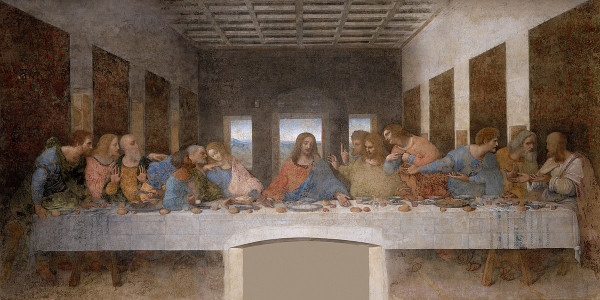
Westerners have no right to accuse the Chinese of blaspheming this sacred symbol since it has been parodied by Westerners themselves an untold number of times (see the example in the picture below).
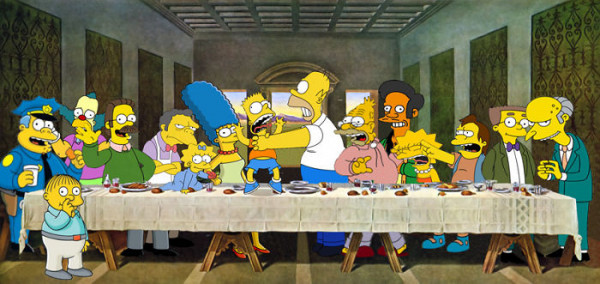
The painting is very suitable for the Chinese purpose, especially with its original title, which the Latvians have not been able to reproduce adequately. The Italian title of the painting, which is not well known in Latvia, is "L'Ultima Cena", but the English with "The Last Supper" or, if one prefers, the Germans with "Das letzte Abendmahl" have ensured that the meaning of the event depicted is well understood. It's the last supper before the death of Jesus Christ on earth. It is a harsh allusion to the USA, which does indeed claim to be God incarnate on earth.
The caricature appeared on Chinese social networks, which were referred to by the PRC government's Global Times. It circulated the parody on June 13, 2021, together with a detailed explanation of the details of the painting, which turns out to be a visualization of the West's list of old and new sins; there is also information on how many hundreds of thousands of views the caricature earned in the first hours of its posting.
In the parody, instead of Christ, of course, the eagle as the national symbol of the Americans is chosen. On both sides of it on the table are cotton buds, reminding us of the country's origins at the expense of slavery. Directly in front of the eagle is a printing machine that converts toilet paper into US dollars. The Global Times has calculated that toilet paper is worth six out of a total of eight trillion US dollars, the amount that had been printed by last summer. On the table to the right of the eagle is a cake with the outline of China, which the eagle would like to eat and feed to his disciples. The caricature is linked in this way to many other caricatures, one of which was published very recently in Neatkarīgā. It was a drawing, now a hundred years old, depicting China not as a cake but as a pizza that England, France, Germany, Russia and Japan wanted to split between them. It is now known that none of the plans of the world powers of the time came to fruition. Yes, this is roughly the line-up of countries that would still like to feast on China, but the Chinese draw caricatures of them and warn that soon the West will no longer be able to swallow China, not even in its wildest dreams.
One of the themes of the cartoon is the denial of Western unity, which E. Levits also stressed so passionately last summer. The three countries are depicted as showing a wait-and-see attitude, perhaps even a dismissive attitude, towards the US calls to do China harm. The disciple on the left, next to Christ, has turned away from him and distanced himself with a hand pose - this is Italian Wolf, which joined the 16+1 format a few years ago, making it 17+1, before Lithuania destroyed this enlargement, at least in numbers. Germany as the blue Eagle uses Angela Merkel's hands to just lean on the table - to do nothing more. The French Rooster, all puffed up and self-absorbed, will not crow to the delight of the Americans.
The donkey-eared Australian Kangaroo, not included in the G7, is trying to grab US dollars with one hand and keep Chinese yuan in the other, i.e. trying to trade actively with China.
The Japanese Dog pours poisoned Fukushima sewage into the Pacific Ocean. The English Lion seems to be willing to listen to the Americans but is confused and entangled in his Brexit. Behind the Lion stands the Canadian Beaver in a red bathrobe with a design of their legalized marijuana. The Beaver holds a doll of a detained, in China's opinion - kidnapped, Huawei official.
The Indian Elephant is not a G7 member, it is trying to suck up to the table of these countries - he is looking for allies against powerful neighbor China. At the Elephant's feet, a "Help Me" bowl heralds India's failure to contain Covid-19 or perhaps alleviate poverty. Taiwanese Frog tries to jump on the table.
Paper and its digital substitutes endure whatever is written or drawn on it. In this case, the Western countries are drawn in such a way as to give the impression that such a company will not be able to gather and feast for much longer. The details of the cartoon are very apt in describing the countries gathered in the anti-China coalition, but the sum of the parts is no guarantee of the future course of the world in the direction of the rise of Chinese power alone. The question is how China achieved its present greatness in the first place, because the cartoons that portray China and the Chinese as a doomed land and people did not lie "literally". One of these cartoons has already been invoked; let us look here at another drawing in which the same idea is expressed in an even harsher way, with one Chinese being beaten by five people (four Europeans and a Japanese), while others rush in to take part in such a pleasant event.
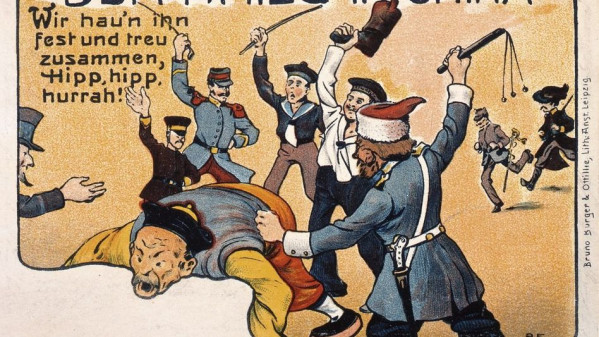
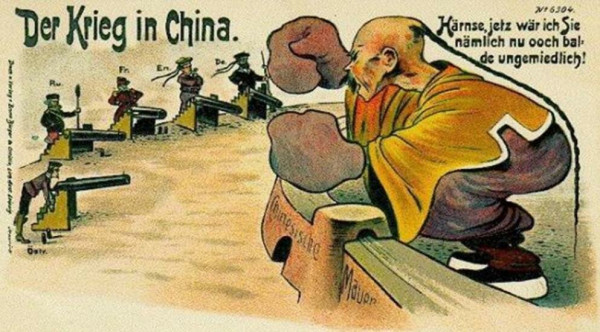
It is a German postcard from 1900 documenting the so-called Boxer Rebellion against foreign interference in China's internal life. The event was hopeless from the start, as its name implies, because the Chinese rebel masses were mostly armed with cold weapons and used eastern martial arts, which the English called "Chinese boxing". And to fight against European firearms in this way, as another postcard (pictured) schematized so accentuated? So it happened, as it happened: between November 1899 and September 1901, the Chinese sacrificed tens of thousands of Chinese Christians and hundreds of thousands of rebels, their supporters and accidental civilians to the extermination of a little over 230 foreigners. Sane people would say - and did say - that such madness showed once again how far the Chinese have degraded.
Indeed, it is only from the vantage point of hindsight that it is beginning to emerge that physically identical actions had different meanings. It is now possible, but not necessary, to see in the Boxer Rebellion evidence that a mass of people had somehow emerged in China for whom an idea was more important than the lives of others, and even their own. If such people had existed in China before, other countries would not have looked upon the Chinese state as the embodiment of powerlessness or futility and as a warehouse left to be plundered, a blanket left to be torn (pictured). Now it is China that is looking in exactly the same way, if not at the whole world, then certainly at many areas of interest to China.
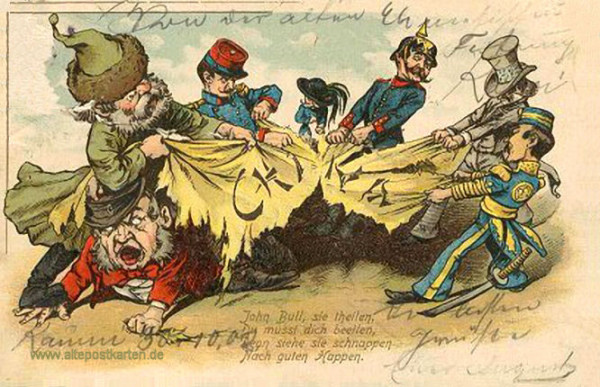
*****
Be the first to read interesting news from Latvia and the world by joining our Telegram and Signal channels.
